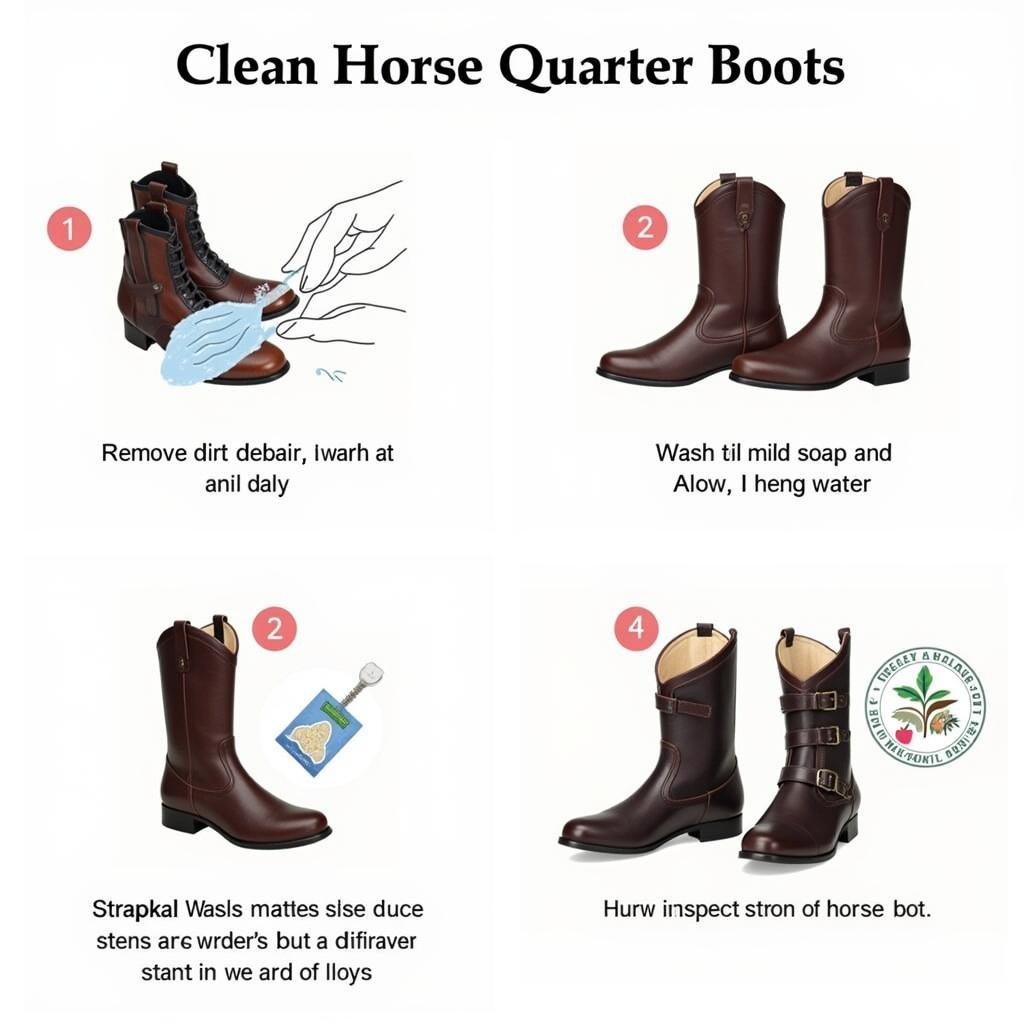Quarter Boots For Horses are an essential piece of equipment for many riders, offering protection and support for the horse’s hooves and lower legs. Whether you’re a seasoned competitor or a weekend trail rider, understanding the benefits and proper usage of quarter boots can significantly impact your horse’s well-being and performance. This comprehensive guide will delve into everything you need to know about quarter boots for horses, from choosing the right type to ensuring a perfect fit.
Types of Quarter Boots and Their Uses
There are various types of quarter boots designed for different disciplines and purposes. Bell boots, or overreach boots, protect the heel and coronary band from overreaching, a common issue where the hind hooves strike the front hooves. Splint boots offer support and protection to the splint bones, located on the inside of the horse’s leg. Skid boots are commonly used in disciplines like reining and barrel racing, providing protection to the fetlocks and heels during sliding stops and quick turns. Brushing boots prevent interference injuries, particularly common in horses with a base-narrow stance or those prone to brushing their legs together. Finally, there are sport boots, designed for various disciplines, offering a combination of protection and support.
Selecting the right type of quarter boot depends largely on the horse’s conformation, discipline, and individual needs. For example, a horse with a history of splint injuries might benefit from splint boots, while a horse competing in barrel racing would require skid boots.
Many horses benefit from support and protection for their hocks. You can learn more about potential hock issues in our article about signs of hock pain in horses.
Choosing the Right Quarter Boots for Your Horse
Choosing the right quarter boots involves considering several factors. The material of the boot is crucial, as different materials offer varying levels of protection, breathability, and durability. Common materials include neoprene, leather, and synthetic fabrics. Neoprene is known for its flexibility and shock-absorbing properties, while leather offers durability and a classic look. Synthetic materials are often lightweight and easy to clean.
The fit of the quarter boot is paramount for both comfort and effectiveness. A boot that is too tight can restrict movement and cause discomfort, while a boot that is too loose can slip and become ineffective, even dangerous. Properly fitted boots should be snug but not restrictive, allowing for full range of motion. Always consult sizing charts and measure your horse’s legs accurately before purchasing any quarter boots.
You can also explore options for enhancing your horse’s appearance with a tail extension horse.
Caring for Your Horse’s Quarter Boots
Proper care and maintenance of quarter boots are essential for prolonging their lifespan and ensuring they remain effective. Regularly cleaning your horse’s quarter boots will prevent the buildup of dirt, sweat, and debris, which can harbor bacteria and cause skin irritations. Most boots can be cleaned with mild soap and water, but always check the manufacturer’s instructions for specific cleaning guidelines. Allow the boots to air dry completely before storing them in a cool, dry place. Inspecting your boots regularly for any signs of wear and tear, such as cracks, tears, or loose straps, will ensure they remain functional and safe for your horse.
Dr. Emily Carter, DVM, Equine Sports Medicine Specialist, emphasizes the importance of proper boot care. “Clean, well-maintained boots are crucial for preventing skin irritations and infections. Regular cleaning and inspection are essential for preserving the integrity of the boots and ensuring they continue to provide optimal protection.”
If you are looking for riding boots for yourself, check out our collection of short horse riding boots.
 Cleaning and Maintaining Horse Quarter Boots
Cleaning and Maintaining Horse Quarter Boots
Conclusion
Quarter boots for horses are a valuable investment for any horse owner, offering protection and support for various disciplines and activities. By understanding the different types of boots, choosing the right fit, and maintaining them properly, you can ensure your horse’s comfort and well-being while maximizing their performance. Remember to consult with your veterinarian or farrier for personalized recommendations regarding quarter boots for your horse. Proper selection and maintenance of quarter boots are crucial for protecting your horse from injuries and ensuring their long-term soundness. Learn more about quarter boots horse.
FAQ
-
How often should I clean my horse’s quarter boots?
Ideally, after every ride, especially if they are particularly dirty or muddy. -
Can I use any type of soap to clean quarter boots?
Mild soap is recommended. Avoid harsh chemicals that can damage the material. -
What are the signs that my horse’s quarter boots no longer fit properly?
Slipping, rubbing, or chafing are indicators of an ill-fitting boot. -
How long do quarter boots typically last?
The lifespan depends on usage and care, but with proper maintenance, they can last for several months to a year or more. -
What should I do if my horse develops a skin irritation under their quarter boots?
Discontinue use immediately and consult your veterinarian. -
Are quarter boots necessary for all horses?
Not necessarily, but they provide valuable protection and support, especially during strenuous activities. -
Can quarter boots help prevent injuries like quarter cracks?
While they won’t directly prevent a horse quarter crack, they can offer some protection and support to the hoof wall.
For further assistance, please contact us at Phone: 0772127271, Email: [email protected] or visit our address: QGM2+WX2, Vị Trung, Vị Thuỷ, Hậu Giang, Việt Nam. Our customer service team is available 24/7.